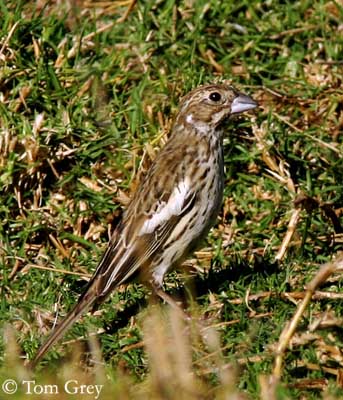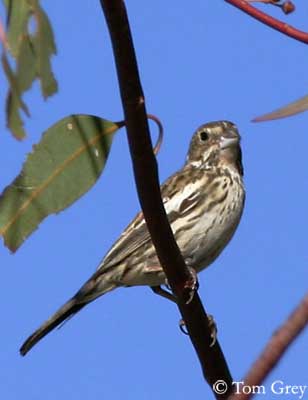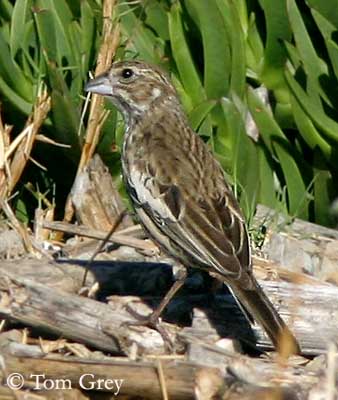
Lark Bunting
Calamospiza melanocorys
Passeriforme Order – Passerellidae Family Family
BIOMETRICS:
Length : 14-18 cm
Wingspan : 28 cm
Weight : 30-51 g
LONGEVITY : Up to 4 years
DESCRIPTION:
Lark Bunting is the official state bird of Colorado adopted on April 29, 1931. It is a medium-sized bird, and the only one that changes out of a bright breeding plumage into a drab winter one.
Lark Bunting adult breeding male has black plumage contrasting with conspicuous white wing patch. This one is formed by white greater and median wing coverts. Black tail is relatively short, a little rounded, with white tips. Some of belly and lower-tail coverts are tipped with white.
Head is black and rather large. Neck is short. We can see some glossy dark green feathers on nape. Conical, pointed, robust bill is blue-grey. Eyes are black. Legs and feet are brown. (Not displayed)
Adult male in basic plumage resembles female but it has black chin, and black colour is extending to belly where we can see whitish feathers edgings.
Female in alternate plumage has greyish-brown upperparts, streaked with dark. She as white wing patches as male, but smaller and tinged with buffy. Female has white underparts streaked with dark on chest and sides. Belly is nearly pure white, and sides are tinged with reddish brown. She is smaller than male.
Female in basic plumage is duller greyish-brown with paler streaks, and more strongly tinged with buff.
Juvenile resembles female but it is buffer overall. The buffy edges on neck and back feathers give an impression of scales. Underparts are streaked, but more extensive than in female.
REPRODUCTION:
Female selects the nest-site, visiting places closely followed by the male. Once a place is selected, female scraps with her feet under a shrub. Male collects material such as grass for nest building. Nest is located in a depression on the ground. It is a loose structure of grass blades, rootlets, leaves and stems. It is lined with finer grasses and hair, and with a final upper rim flush with ground. Rim may also be above the ground or at ground level.
Female lays 3 to 6 light blue eggs. Incubation lasts about 10 to 11 days, mainly by female, occasionally fed by male. Both parents attend nest and protect eggs from cold and heat.
Altricial chicks are brooded and fed by both adults. Male may bring food to female and she feeds the young. They leave the nest 8 to 9 days after hatching, but they are unable to fly and remain in vicinity of nest, concealed in vegetation. They are fed by both parents for some days more.
This species usually produces one brood per year, rarely two.
DIET:
Lark Bunting feeds on seeds, grains and insects, and some fruits in winter. During summer, they feed on insects such as grasshoppers, ants, beetles, bugs and seeds of wild plants, grains and plant matter.
PROTECTION / THREATS / STATUS:
Lark Bunting is threatened by pesticides used for grasshopper control, collisions with vehicles during migrations and breeding season, degradation of habitat and changes for overgrazing, disturbances at nest sites.
They may be hosts of Brown-headed Cowbird and they are preyed upon by domestic cats when birds come to drink out to water tanks.
Populations of Lark Buntings appear to be declining.
Fr: Bruant noir et blanc
All : Prärieammer
Esp : Sabanero de Alas Pálidas
Ital : Zigolo allodola americano
Nd : Dikbekgors
Sd : Svartsparv
Photographs by Tom Grey
His website : Tom Grey's Bird Pictures
Text by Nicole Bouglouan
Sources:
A GUIDE TO THE BIRDS OF MEXICO AND NORTHERN CENTRAL AMERICA by Steve N. G. Howell, Sophie Webb - Oxford University Press - ISBN: 0198540124
BIRDS OF THE GREAT BASIN – by Fred A. Ryser - Univ of Nevada Pr -ISBN: 0874170796
FIELD GUIDE TO THE BIRDS OF NORTH AMERICA - National Geographic Society - ISBN: 0792274512
All About Birds (Cornell Lab of Ornithology)
What Bird-The ultimate Bird Guide (Mitchell Waite)
Wikipedia (Wikipedia, The Free Encyclopedia)

VOICE: SOUNDS BY XENO-CANTO
Lark Bunting’s call is a soft “hoo-ee” given in flock. Adults bringing food to young at nest utter “whert” or “wheert” calls. Response of young to adults is a buzz call.
Lark Bunting’s song is a varied series of whistles and trills, both sweet and harsh in tone. Songs may be given from perches and during flights.
HABITAT:
Lark Bunting breeds in plains, meadows and areas up to 8000 feet in elevation. We find them in shrubby steppes of high plains and in cultivated areas. During spring and fall migrations, they live in similar habitats.
They winter in cultivated and brushy areas, and desert.
RANGE:
Lark Bunting breeds in Great Plains from southern Alberta and Saskatchewan to northern Texas and NE New Mexico.
They winter from southern Great Plains to Central Mexico.
BEHAVIOUR:
Lark Bunting hops while foraging on the ground. It walks and also runs when pursuing a prey.
Male’s interactions occur. The most common consists of territorial male utters a song flight towards another male, and lands close to it, while a second male is flying away. When the intruder doesn’t flee territory, the owner uses visual displays such as wing-flicks, fluffed-feathers, and tilted-body posture at close range from the ground or any perch. If the intruder persists, the owner may rush it. A direct attack may occur with feet pulling.

In order to establish and maintain territory, males perform some behaviour. At about 7 to 8 metres of height, male performs a steep ascent with rapid wing beats. Then, wing beats become deeper and slower, almost mechanical. At the end, the bird does a final glide to ground or perch, while performing jerky flaps of wings towards the end of the glide.
They also can use other display, starting low at about 1 to 2 metres, and parallel to the ground. These displays, usually performed with other males, can reach 5 to 6 metres of high. Males split up and fly in an arc back to their territories. If one male is alone, display is given in a sweeping arc delineating territory, or it performs direct flights at about 1 to 3 metres above the ground, leaving or returning to territory.
During courtship period, male and female spend a lot of time together on territory, and male is almost completely silent. At this time, no obvious courtship or precopulatory displays are given. Male hops around after female and sometimes attempts to mount her. This species doesn’t perform conspicuous ground displays.
Before copulation, female draws head back with bill up and open, closed and raised tail, wings partly spread and body crouched. Male hops by female, dropping onto his tarsi, and bobs up and down. Occasionally it copulates with female holding grass stem in the bill. Copulation begins during nest-building.
Lark Bunting is gregarious during migration and in winter. Flocks may include a few dozen to several hundreds birds, but they may be thousands around abundant food resources.
When alarmed or threatened, lark Bunting may give alarm calls and perform some displays for defending nest and chicks. They also perform distraction display such as ‘broken-wing act” or “mouse-like run”.
FLIGHT:
Lark Bunting has direct flight. Usually, its flight is a low, gliding motion, overtopping weeds and bushes. Aerial song flight is described as “Butterfly flight”.
